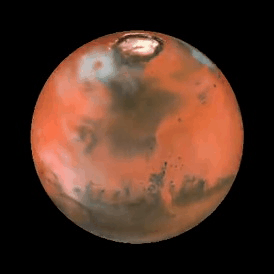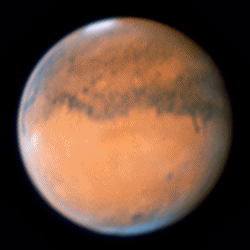

-
Mars and Earth have approximately the same landmass.
Even though Mars has only 15% of the Earth’s volume and just over 10% of the Earth’s mass, around two thirds of the Earth’s surface is covered in water. Martian surface gravity is only 37% of the Earth’s (meaning you could leap nearly three times higher on Mars). -
Mars is home to the tallest mountain in the solar system.
Olympus Mons, a shield volcano, is 21km high and 600km in diameter. Despite having formed over billions of years, evidence from volcanic lava flows is so recent many scientists believe it could still be active.



-
Mars has the largest dust storms in the solar system.
They can last for months and cover the entire planet. The seasons are extreme because its elliptical (oval-shaped) orbital path around the Sun is more elongated than most other planets in the solar system. -
On Mars the Sun appears about half the size as it does on Earth.
At the closest point to the Sun, the Martian southern hemisphere leans towards the Sun, causing a short, intensely hot summer, while the northern hemisphere endures a brief, cold winter: at its farthest point from the Sun, the Martian northern hemisphere leans towards the Sun, causing a long, mild summer, while the southern hemisphere endures a lengthy, cold winter.

Mars Diagram
Facts about Mars
-
Mars is the second smallest planet in the solar system after mercury.
-
Mars is also referred to as the “Red Planet”
-
Mars has a thin atmosphere.
-
Mars takes twice the time Earth takes to complete a full revolution around the sun.
-
Did you know that the giant Jupiter has the ability to influence the orbit of Mars?
MORE MARS FACTS
-
Pieces of Mars have fallen to Earth.
Scientists have found tiny traces of Martian atmosphere within meteorites violently ejected from Mars, then orbiting the solar system amongst galactic debris for millions of years, before crash landing on Earth. This allowed scientists to begin studying Mars prior to launching space missions. -
Mars takes its name from the Roman god of war.
The ancient Greeks called the planet Ares, after their god of war; the Romans then did likewise, associating the planet’s blood-red colour with Mars, their own god of war. Interestingly, other ancient cultures also focused on colour – to China’s astronomers it was ‘the fire star’, whilst Egyptian priests called on ‘Her Desher’, or ‘the red one’. The red colour Mars is known for is due to the rock and dust covering its surface being rich in iron. -
There are signs of liquid water on Mars.
For years Mars has been known to have water in the form of ice. The first signs of trickling water are dark stripes or stains on crater wall and cliffs seen in satellite images. Due to Mars’ atmosphere this water would have to be salty to prevent it from freezing or vaporising. -
One day Mars will have a ring.
In the next 20-40 million years Mars’ largest moon Phobos will be torn apart by gravitational forces leading to the creation of a ring that could last up to 100 million years.
